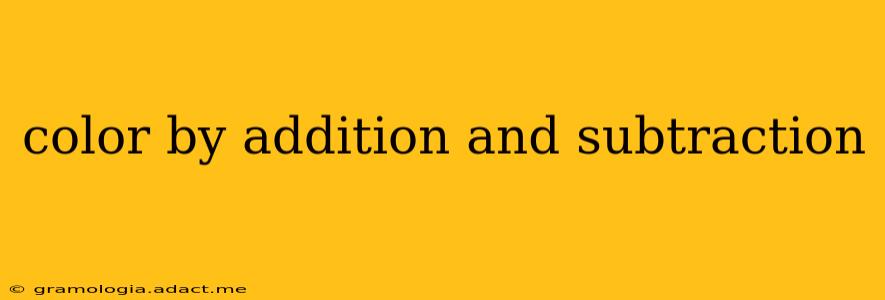Understanding how colors interact is fundamental to any creative pursuit, from painting and graphic design to photography and even cooking. This exploration delves into the fascinating world of color mixing, focusing on the additive and subtractive methods. We'll unravel the mysteries behind these systems, explaining their principles and practical applications. Whether you're a seasoned artist or a curious beginner, this guide will illuminate the core concepts of color by addition and subtraction.
What is Additive Color Mixing?
Additive color mixing is a process where light sources are combined to create new colors. The primary colors in additive mixing are red, green, and blue (RGB). These are the colors that are used in screens (monitors, TVs, smartphones) and projectors. When you combine these primary colors, you get:
- Red + Green = Yellow
- Red + Blue = Magenta
- Green + Blue = Cyan
- Red + Green + Blue = White
The absence of light results in black. This is why your computer screen displays black when it's turned off—it's not emitting any light. Additive color mixing is based on the principle of light emission and how our eyes perceive the combined wavelengths.
What is Subtractive Color Mixing?
Subtractive color mixing involves combining pigments (paints, inks, dyes) to create new colors. Unlike additive color mixing, where light is added, subtractive mixing works by subtracting wavelengths of light. The primary colors in subtractive mixing are cyan, magenta, and yellow (CMY). These are typically used in printing processes. When you combine these primary colors, you get:
- Cyan + Magenta = Blue
- Cyan + Yellow = Green
- Magenta + Yellow = Red
- Cyan + Magenta + Yellow = Black (theoretically)
In practice, a true black is often difficult to achieve with just CMY, so a key (black) pigment, K, is added to the mix, resulting in the CMYK color model commonly used in printing. The absence of pigment results in white, as the underlying surface reflects all colors of light.
What is the difference between RGB and CMYK?
The key difference lies in how colors are produced. RGB uses light emission, while CMYK uses pigment absorption. RGB is for screens, while CMYK is for printing. A color that looks vibrant on your screen might appear duller when printed, because the methods of color creation are fundamentally different.
How does the color wheel work in additive and subtractive color mixing?
The color wheel is a visual representation of the relationships between colors. While the arrangement of colors is similar in both systems, the interpretation and primary colors differ. In additive mixing, the primary colors are located at equal distances on the wheel, and mixing them produces white in the center. Subtractive mixing uses cyan, magenta, and yellow as primary colors, resulting in black in the center (ideally, though in practice it's often CMYK to achieve a richer black).
What are complementary colors?
Complementary colors are pairs of colors that are opposite each other on the color wheel. When mixed, they theoretically neutralize each other, tending towards a neutral gray or brown in subtractive mixing or white in additive mixing. Examples include red and cyan (in subtractive) or red and green (in additive). Understanding complementary colors is crucial for creating visual harmony or contrast in design and art.
Can I use the same color mixing principles in digital art?
Yes, the principles of additive and subtractive color mixing are relevant to digital art. Digital art programs use the RGB color model for on-screen display, while printed outputs utilize the CMYK system. Understanding the distinctions between these two systems helps artists ensure the accuracy and consistency of their work across various media.
This comprehensive explanation of color by addition and subtraction provides a strong foundation for understanding color theory and its applications. Whether you're creating artwork, designing websites, or simply appreciating the beauty of color, mastering these principles will significantly enhance your creative endeavors.
